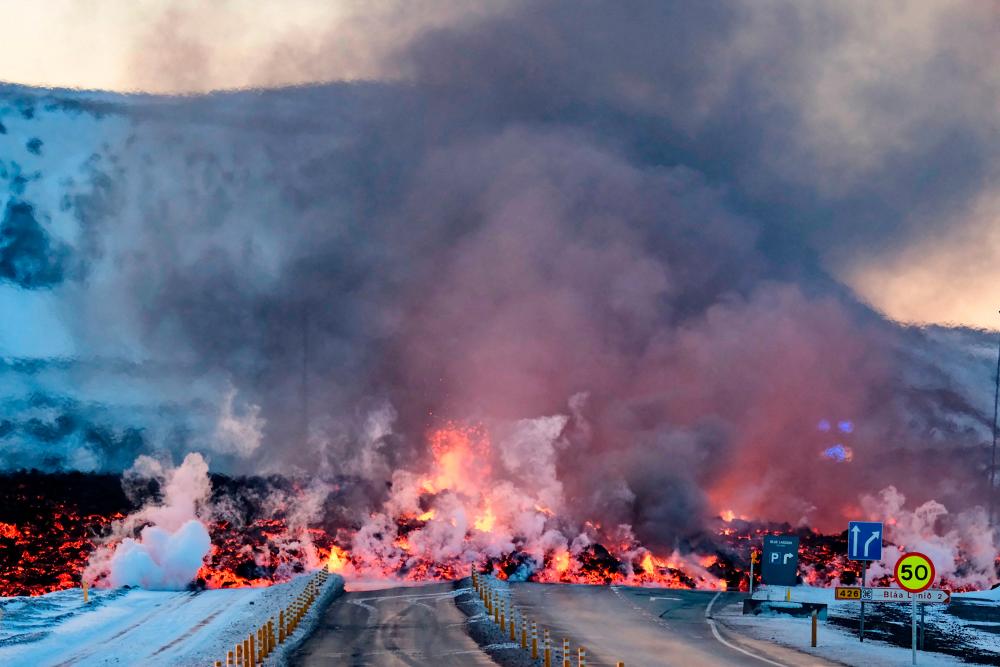REYKJAVIK: Glowing lava spewed early Thursday from a new volcanic fissure on Iceland’s Reykjanes peninsula, the third eruption to hit the area since December, with authorities raising the alert level as a key water pipe was threatened.
Video images of the crack in the Earth’s surface, stretching an estimated three kilometres (two miles), showed the fissure illuminating a plume of smoke rising under the dark sky that was visible from the capital of Reykjavik.
Iceland’s Department of Civil Protection and Emergency Management raised the public alert level to one step short of a state of emergency, as lava was spreading over pipes that transport hot water to the Reykjanes peninsula.
“We are working on figuring out the next steps to make sure people get warm water,“ spokeswoman Hjordis Gudmundsdottir told AFP, saying the water was also used to heat homes around the peninsula.
The department encouraged residents to refrain from using hot water for showers and baths, fearing a severe shortage if the supply would be cut off.
The site is around 40 kilometres southwest of Reykjavik, in the same area as two previous eruptions, the first on December 18 and the second on January 14, near the fishing village of Grindavik.
“At 5:30 this morning an intense seismic activity started northeast of Mt. Sylingarfell. Around 30 minutes later, a volcanic eruption started at the site,“ the Icelandic Meteorological Office (IMO) said in a statement.
The office said the fissure’s length was based on a flyover by the Coast Guard.
- Town evacuated -
The roughly 4,000 residents of Grindavik had to be evacuated on November 11 after hundreds of earthquakes damaged buildings and opened up huge cracks in roads, shrouding the village’s future in doubt.
The quakes were followed by a fissure on December 18 that spared the village, but a second on January 14 opened right on the town’s edge, sending orange lava flowing into the streets and reducing three homes to ashes.
Residents have only been allowed back for short visits since the second eruption.
Thursday’s eruption occurred around four to five kilometres north of Grindavik and two to three kilometres west of the Svartsengi power plant, which supplies electricity to around 30,000 people on the Reykjanes peninsula.
Authorities were trying to establish if the lava might flow towards the plant.
“We’re trying to figure that out right now, we have helicopters in the air and we’re taking measurements to see how the lava is flowing and where it could possibly go,“ Gudmundsdottir said.
The plant was evacuated and has been run remotely since the first eruption in the region, and dykes have been built to protect it.
“The dykes are about 8-10 metres high, made of earth. They encircle the whole plant,“ Gudmundsdottir said.
Fountains of lava from Thursday’s eruption reached 50 to 80 metres high in some areas and the volcanic plume rose about three kilometres above the fissure, the IMO said.
“Lava flows mostly towards west at the moment and the flow seems to be slightly less than at the start of the 18th of December eruption,“ the office said.
Seismologist Kristin Jonsdottir said the location of the new eruption was “fortunate” as it was north of Grindavik and away from infrastructure, the broadcaster RUV reported.
The IMO had warned Monday that magma accumulation beneath the area was continuing, noting that “there is an increased likelihood of a new magmatic dyke intrusion and ensuing volcanic eruption in the coming days to weeks”.
- New era? -
Iceland’s famed Blue Lagoon geothermal spa, a few kilometres north of the eruption, said it had closed Thursday and all guests staying at the resort had been evacuated, with lava later overflowing a road leading to the site.
Iceland is home to 33 active volcano systems, the highest number in Europe.
It straddles the Mid-Atlantic Ridge, a crack in the ocean floor separating the Eurasian and North American tectonic plates.
But until March 2021, the Reykjanes peninsula had not experienced an eruption for eight centuries.
Further eruptions occurred in August 2022 and in July and December 2023, leading volcanologists to say it was probably the start of a new era of seismic activity in the region. -AFP









